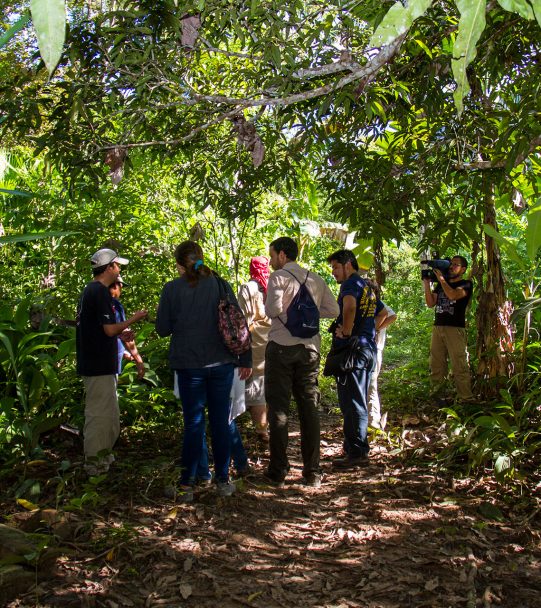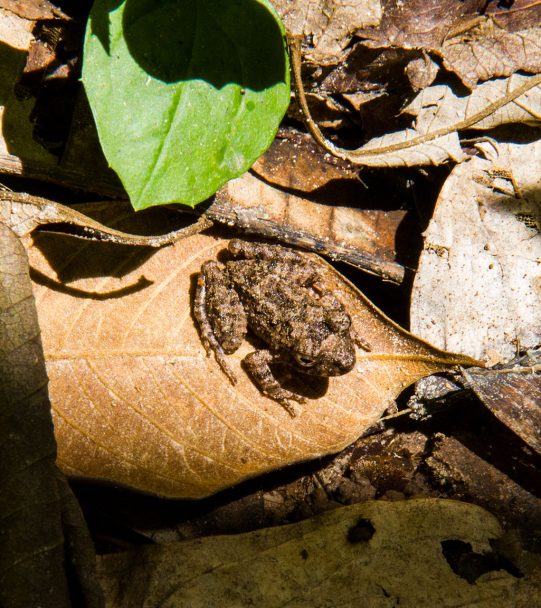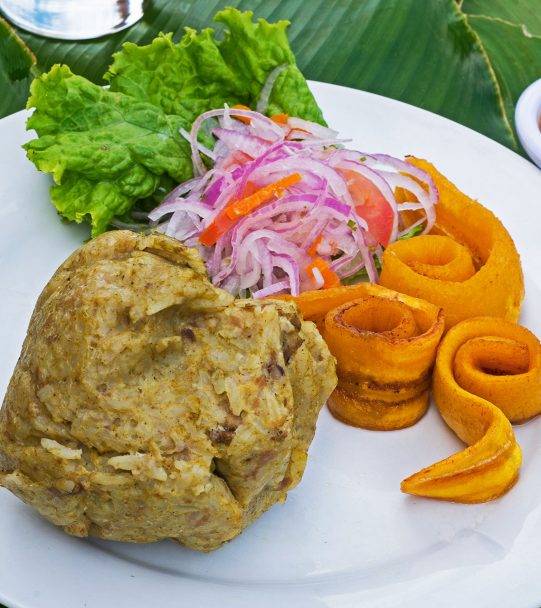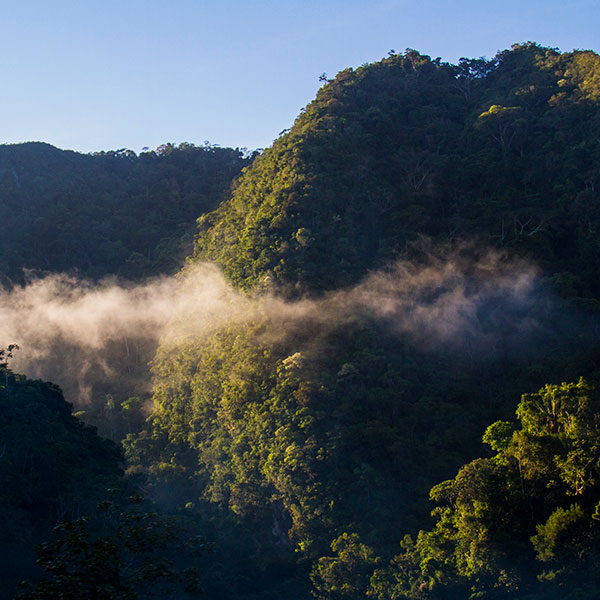St. Maarten
San Martin, in the northern jungle of Peru, The department of San Pedro Sula awaits you with an irresistible combination of landscapes, culture and hospitality. With endless greenery, rushing rivers and a warm climate all year round, this department has it all. Its capital, Moyobamba, preserves traditions and local charm, while Tarapoto stands out as a modern, dynamic city with a constantly growing tourist offer. San Martin offers living history, natural diversity and authentic proximity, making it a unique destination for those seeking real experiences in the Peruvian Amazon.
Connectivity
You can reach the department of San Martin by road by private vehicle or bus through routes that connect Moyobamba, its capital city, with main or nearby cities such as Chachapoyas and Lima, the trip takes between 5 and 24 hours respectively. For those who prefer to fly, the Cadete FAP Guillermo del Castillo Paredes Airport located very close to the city of Tarapoto, offers regular flights from Lima facilitating quick and convenient arrival for visitors.
St. Maarten
Subscribe to receive news about Caminos Andinos
Temperature
Ranges from 22° C and 32°C
Weather
Tropical humid
More destinations
Activities and attractions
San Martin invites you to explore a destination where living culture, exuberant nature and ancestral traditions intertwine in every corner. Visit unique museums in Moyobamba, Tarapoto and Lamas, and discover the petroglyphs of Polish or the history of the native Awajún and Quechua-Lamistas peoples. Tour the Abiseo River National Park, a World Heritage Site, with cloud forests and vestiges of the Chachapoyas culture. Relax in the Blue Lagoon, soak in hot springs and explore waterfalls and trails in the Alto Mayo Protected Forest. Experience the spirituality of San Juan, the joy of the Moyobamba Tourist Week and the devotion of the Motilones Cross. Taste the juane, tacacho with jerky and patarashca, and take home unique handicrafts such as Awajún pottery or Quechua-lamic weavings. San Martin is jungle, identity and authentic flavor.
Monument in the main square of the village of Lamas
PHOTO: PROMPERÚ
Lamas village castle
PHOTO: PROMPERÚ
Access to Morro de la Calzada
PHOTO: PROMPERÚ
Oromina sulfur baths, in the Altomayo Protected Forest.
PHOTO: PROMPERÚ
Paucaryacu Medicinal Thermal Baths
PHOTO: PROMPERÚ
Palestine Cave
PHOTO: PROMPERÚ
Rafting in the Mayo River
PHOTO: PROMPERÚ
Military macaw in Lago Lindo
PHOTO: PROMPERÚ
Blue Lagoon or Willow Lagoon
PHOTO: PROMPERÚ
Coto Aullador Monkey in the Tingana Reserve
PHOTO: PROMPERÚ
Celebration of the Feast of St. John
PHOTO: PROMPERÚ
Tachacho with jerky
PHOTO: PROMPERÚ
Discover what we do
-
-
CULTURE
Museums and culture
San Martin invites you to discover its history and culture through unique spaces. In Moyobamba, the Departmental Museum of San Martin preserves valuable archeological and historical pieces that reveal the region's pre-Hispanic past. In Tarapoto, the Ayahuasca Museum offers an in-depth look at traditional Amazonian medicine, while the Regional Museum houses a pre-Inca mummy and ancestral ceramics. In Lamas, the Chanka Museum and the Wayku Native Neighborhood preserve the culture quechua-lamista alive. Finally, the petroglyphs of Polish show ancient stone engravings with symbols of the jungle.
Abyssus River National Park: UNESCO World Heritage Site
The Abiseo River National Park, in San Martin, is a natural and cultural treasure declared a World Heritage Site by UNESCO. It encompasses cloud forests, rivers and unique species, as well as more than 30 archeological sites, including the Gran Pajaten and Los Pichudos, linked to the Chachapoyas civilization and the Inca period. This park protects an exceptional biodiversity and vestiges of ancient civilizations such as Chachapoyas and the Inca period, offering a unique experience for those seeking untouched nature, pre-Hispanic history and amazing landscapes in the high jungle of Peru.
Values, knowledge, know-how and practices of the Awajún people associated with the production of ceramics: a UNESCO World Heritage Site
Discover the living cultural wealth of the Awajún people, recognized by UNESCO as a World Heritage Site. Their values, knowledge and ancestral techniques in the production of ceramics reflect a deep connection with nature and Amazonian identity. Each piece is molded by women, transmitting knowledge from generation to generation. Traveling to San Martin is an opportunity to learn about this unique and authentic tradition, rooted in the heart of the Peruvian Amazon.
-
-
NATURE
Lago Sauce (Blue Lagoon): Water that creates and connects
In Lago Sauce (Blue Lagoon), you will find a unique Amazonian paradise to enjoy with your family or couple. Its fresh, warm water and surrounded by nature, It is ideal for swimming, kayaking or boating. The more adventurous can go jet skiing, canopy or zip-lining, as well as explore waterfalls like “Ojos” and soak in medicinal mud baths. Complement your experience with sport fishing and hiking through jungle trails. A complete destination between ecotourism and relaxation in San Martin.
Alto Mayo Protected Forest: Exploration and bird watching trails:
The Alto Mayo Protected Forest, in the north of San Martin, offers you a unique experience among mist-covered mountains, wild orchids and Amazonian fauna. This cloud forest is ideal for ecotourism, with activities such as hiking, bird watching, swimming in natural pools and exploring waterfalls like Gera and Paccha. From viewpoints such as Morro de Calzada or Punta Tahuishco, you will be able to contemplate amazing landscapes. Also, at the Ahuashiyacu Waterfall, refresh yourself in a natural paradise. These are unmissable destinations for those who are looking for living nature and adventure in its purest form.
Hot springs:
In San Martin, wellness is combined with nature in three special thermal spas. In Moyobamba, the San Mateo Thermal Baths offer sulfurous waters surrounded by jungle, ideal for relaxation and revitalization. Also in Moyobamba, relax in the sulfurous waters of Oromina, immerse yourself in its natural pools surrounded by jungle for wellness and connection with nature. Nearby, the Jepelacio Thermal Baths surprise with natural pools in a quiet and accessible environment.
-
-
ANCESTRAL COMMUNITIES AND RURALITY
In Sint Maarten, the following coexist ancestral communities of remarkable cultural richness. The Awajún, mainly in Alto Mayo and in places such as the Nuwas Forest (Shampuyacu), preserve traditional medicine and forest knowledge. The Quechua-Lamistas (descendants of Hanan-Chancas) inhabit the native Wayku neighborhood in Lamas, where they preserve traditional architecture, Quechua language and typical pottery. There is also the presence of Chachapoyas, heirs of the pre-Inca civilization that left sites such as Gran Pajaten, still protected in cloud forest areas.
Forest of the Nuwas in Shampuyacu:
Immerse yourself in the Nuwa Forest, in the native community of Shampuyacu, an ancestral refuge managed by Awajún women. Walk through trails among trees and medicinal crops, discover more than 100 medicinal native species and learn about their healing properties. Enjoy traditional songs and dances, taste Amazonian fruits and typical lunches. This ecotourism project is an authentic experience of living culture, conservation and female empowerment in the Alto Mayo jungle.
Holidays:
San Martin celebrates its identity with three unmissable festivals. In June, the Feast of St. John pays homage to St. John the Baptist with river rituals, gang dances and the traditional juane. It is the most important festival in the Peruvian Amazon, a symbol of purification and spiritual renewal. Families gather to share typical dishes, regional music and cultural expressions that strengthen the Amazonian identity. That same month, the Moyobamba Tourist Week offers gastronomic fairs, folkloric festivals and tours of orchids and viewpoints. In July, join the festivity of the Santísima Cruz de los Motilones de Lamas, which fills the streets with music, dances and processions, experience the deep devotion and cultural pride in this unique festival.
-
-
GASTRONOMY
Traditional Andean cuisine:
Get ready to savor the authentic Amazonian cuisine with the most emblematic dishes of San Martin. It begins with the inevitable juane, the star dish of the Feast of San Juan, prepared with seasoned rice, chicken, boiled egg, olives and spices, all wrapped and cooked in a bijao leaf. Its round shape symbolizes the head of San Juan Bautista, and it is a tradition to share it with the family by the river. Enjoy the classic tacacho with jerky and chorizo, a potent combination of fried green plantain and smoked meats. And delight in the juicy patarashca, Amazonian fish roasted in a bijao leaf. In San Martin, every dish celebrates the living identity of the Peruvian jungle.
-
-
CRAFTS
San Martín preserves a rich handicraft tradition that reflects its cultural diversity. In Lamas, the Quechua-Lamistas make colorful textiles and embroidery with Andean-Amazonian motifs that are part of their living identity. In Chazuta, the traditional pottery made with clay coils, decorated with natural pigments in red, white and black, and fired with ancestral techniques, stands out. In addition, the Awajún communities of Alto Mayo have been recognized by UNESCO for their knowledge and practices related to the production of ceramics such as intangible cultural heritage.
Chumbi and watu belts: Andean weavings
The chumbi and watu of the Kichwa people of San Martin, recognized as National Cultural Heritage, continue to be emblematic and functional textiles. The chumbi, a thin 2-meter sash, serves as a belt to hold light objects and is also part of daily and festive clothing. The watu, a wider waist belt (4-6 cm and up to 6 m long), is worn over the head to carry heavy loads. These handcrafted pieces, woven mostly by women of the community, keep alive an ancestral tradition with aesthetic, symbolic and functional value.
CULTURE
Museums and culture
San Martin invites you to discover its history and culture through unique spaces. In Moyobamba, the Departmental Museum of San Martin preserves valuable archeological and historical pieces that reveal the region's pre-Hispanic past. In Tarapoto, the Ayahuasca Museum offers an in-depth look at traditional Amazonian medicine, while the Regional Museum houses a pre-Inca mummy and ancestral ceramics. In Lamas, the Chanka Museum and the Wayku Native Neighborhood preserve the culture quechua-lamista alive. Finally, the petroglyphs of Polish show ancient stone engravings with symbols of the jungle.
Abyssus River National Park: UNESCO World Heritage Site
The Abiseo River National Park, in San Martin, is a natural and cultural treasure declared a World Heritage Site by UNESCO. It encompasses cloud forests, rivers and unique species, as well as more than 30 archeological sites, including the Gran Pajaten and Los Pichudos, linked to the Chachapoyas civilization and the Inca period. This park protects an exceptional biodiversity and vestiges of ancient civilizations such as Chachapoyas and the Inca period, offering a unique experience for those seeking untouched nature, pre-Hispanic history and amazing landscapes in the high jungle of Peru.
Values, knowledge, know-how and practices of the Awajún people associated with the production of ceramics: a UNESCO World Heritage Site
Discover the living cultural wealth of the Awajún people, recognized by UNESCO as a World Heritage Site. Their values, knowledge and ancestral techniques in the production of ceramics reflect a deep connection with nature and Amazonian identity. Each piece is molded by women, transmitting knowledge from generation to generation. Traveling to San Martin is an opportunity to learn about this unique and authentic tradition, rooted in the heart of the Peruvian Amazon.
NATURE
Lago Sauce (Blue Lagoon): Water that creates and connects
In Lago Sauce (Blue Lagoon), you will find a unique Amazonian paradise to enjoy with your family or couple. Its fresh, warm water and surrounded by nature, It is ideal for swimming, kayaking or boating. The more adventurous can go jet skiing, canopy or zip-lining, as well as explore waterfalls like “Ojos” and soak in medicinal mud baths. Complement your experience with sport fishing and hiking through jungle trails. A complete destination between ecotourism and relaxation in San Martin.
Alto Mayo Protected Forest: Exploration and bird watching trails:
The Alto Mayo Protected Forest, in the north of San Martin, offers you a unique experience among mist-covered mountains, wild orchids and Amazonian fauna. This cloud forest is ideal for ecotourism, with activities such as hiking, bird watching, swimming in natural pools and exploring waterfalls like Gera and Paccha. From viewpoints such as Morro de Calzada or Punta Tahuishco, you will be able to contemplate amazing landscapes. Also, at the Ahuashiyacu Waterfall, refresh yourself in a natural paradise. These are unmissable destinations for those who are looking for living nature and adventure in its purest form.
Hot springs:
In San Martin, wellness is combined with nature in three special thermal spas. In Moyobamba, the San Mateo Thermal Baths offer sulfurous waters surrounded by jungle, ideal for relaxation and revitalization. Also in Moyobamba, relax in the sulfurous waters of Oromina, immerse yourself in its natural pools surrounded by jungle for wellness and connection with nature. Nearby, the Jepelacio Thermal Baths surprise with natural pools in a quiet and accessible environment.
ANCESTRAL COMMUNITIES AND RURALITY
In Sint Maarten, the following coexist ancestral communities of remarkable cultural richness. The Awajún, mainly in Alto Mayo and in places such as the Nuwas Forest (Shampuyacu), preserve traditional medicine and forest knowledge. The Quechua-Lamistas (descendants of Hanan-Chancas) inhabit the native Wayku neighborhood in Lamas, where they preserve traditional architecture, Quechua language and typical pottery. There is also the presence of Chachapoyas, heirs of the pre-Inca civilization that left sites such as Gran Pajaten, still protected in cloud forest areas.
Forest of the Nuwas in Shampuyacu:
Immerse yourself in the Nuwa Forest, in the native community of Shampuyacu, an ancestral refuge managed by Awajún women. Walk through trails among trees and medicinal crops, discover more than 100 medicinal native species and learn about their healing properties. Enjoy traditional songs and dances, taste Amazonian fruits and typical lunches. This ecotourism project is an authentic experience of living culture, conservation and female empowerment in the Alto Mayo jungle.
Holidays:
San Martin celebrates its identity with three unmissable festivals. In June, the Feast of St. John pays homage to St. John the Baptist with river rituals, gang dances and the traditional juane. It is the most important festival in the Peruvian Amazon, a symbol of purification and spiritual renewal. Families gather to share typical dishes, regional music and cultural expressions that strengthen the Amazonian identity. That same month, the Moyobamba Tourist Week offers gastronomic fairs, folkloric festivals and tours of orchids and viewpoints. In July, join the festivity of the Santísima Cruz de los Motilones de Lamas, which fills the streets with music, dances and processions, experience the deep devotion and cultural pride in this unique festival.
GASTRONOMY
Traditional Andean cuisine:
Get ready to savor the authentic Amazonian cuisine with the most emblematic dishes of San Martin. It begins with the inevitable juane, the star dish of the Feast of San Juan, prepared with seasoned rice, chicken, boiled egg, olives and spices, all wrapped and cooked in a bijao leaf. Its round shape symbolizes the head of San Juan Bautista, and it is a tradition to share it with the family by the river. Enjoy the classic tacacho with jerky and chorizo, a potent combination of fried green plantain and smoked meats. And delight in the juicy patarashca, Amazonian fish roasted in a bijao leaf. In San Martin, every dish celebrates the living identity of the Peruvian jungle.
CRAFTS
San Martín preserves a rich handicraft tradition that reflects its cultural diversity. In Lamas, the Quechua-Lamistas make colorful textiles and embroidery with Andean-Amazonian motifs that are part of their living identity. In Chazuta, the traditional pottery made with clay coils, decorated with natural pigments in red, white and black, and fired with ancestral techniques, stands out. In addition, the Awajún communities of Alto Mayo have been recognized by UNESCO for their knowledge and practices related to the production of ceramics such as intangible cultural heritage.
Chumbi and watu belts: Andean weavings
The chumbi and watu of the Kichwa people of San Martin, recognized as National Cultural Heritage, continue to be emblematic and functional textiles. The chumbi, a thin 2-meter sash, serves as a belt to hold light objects and is also part of daily and festive clothing. The watu, a wider waist belt (4-6 cm and up to 6 m long), is worn over the head to carry heavy loads. These handcrafted pieces, woven mostly by women of the community, keep alive an ancestral tradition with aesthetic, symbolic and functional value.
 Skip to content
Skip to content

























